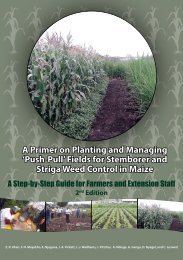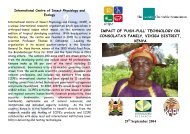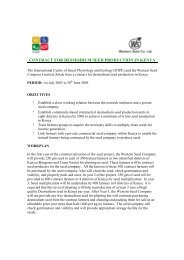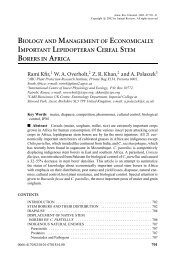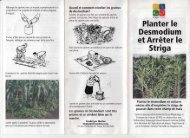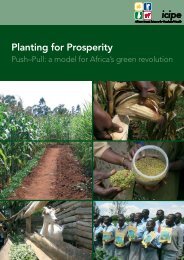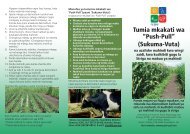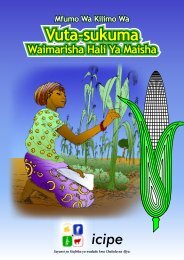The Royal Society Report - Push-Pull
The Royal Society Report - Push-Pull
The Royal Society Report - Push-Pull
Create successful ePaper yourself
Turn your PDF publications into a flip-book with our unique Google optimized e-Paper software.
It would be necessary to confirm that the newly produced<br />
compounds did not affect the palatability or safety of the<br />
food products from the engineered crops. However, as the<br />
dhurrin pathway in this example is transferred from a crop<br />
plant (sorghum), there is no reason in principle why the<br />
approach would be incompatible with safe food and it<br />
could be used to transfer insect resistance in, for example,<br />
potato leaves. <strong>The</strong> example also establishes the principle<br />
that complete metabolic pathways can be transferred<br />
between plants using gene technology without having<br />
complex secondary effects (Kristensen et al. 2005).<br />
Artificial resistance mechanisms<br />
One of the most successful GM approaches to disease<br />
resistance, particularly to plant viruses, involves a concept<br />
known as parasite-derived resistance. A gene from a<br />
pathogen or parasite is introduced either intact or as a<br />
fragment into the genome of a host organism in the<br />
expectation that its RNA or protein product would interfere<br />
with the parasite such that the transformed plant would be<br />
resistant (Fuchs & Gonsalves 2007). Parasite-derived<br />
resistance can operate through RNA- or protein-based<br />
mechanisms and probably the best established examples<br />
involve resistance against viruses. Parasite-derived<br />
resistance in GM papaya against papaya ring spot virus is<br />
used very successfully in Hawaii and could be employed in<br />
many other examples.<br />
RNA-based, parasite-derived resistance against nematodes<br />
and herbivorous insects is starting to be tested (Huang<br />
et al. 2006; McCarter 2009). <strong>The</strong> initial results indicate that<br />
in the longer term (10 years or more) this approach could<br />
underpin useful technologies for crop protection against<br />
pests and pathogens other than viruses.<br />
Another approach allows control of invertebrate pests<br />
with plants that are engineered to make insecticidal<br />
proteins. One of the most successful applications of GM<br />
technology involves crops engineered to make the<br />
insecticidal protein from Bt (Gould 1998; O’Callaghan<br />
et al. 2005). <strong>The</strong>se plants show elevated resistance to<br />
insects such as corn borer, corn rootworm and cotton boll<br />
weevil and, due to careful management with refugia as<br />
discussed in Section 3.3.3.2 (<strong>The</strong> need to manage disease<br />
resistance) (Gould 1998), there are only a few indications<br />
of insects evolving to overcome the resistance in the field.<br />
<strong>The</strong> Bt approach has been or could be used to protect<br />
maize, cotton, potato, brassicas and other plants against<br />
various pests and it may even be effective against<br />
nematodes (Wei et al. 2003). <strong>The</strong> use of GM Bt crops has<br />
resulted in substantial reductions in the application of<br />
insecticides that are toxic to non-target insects and<br />
farmers (Qaim 2009). <strong>The</strong> next generation of Bt maize<br />
lines are designed to express six different Bt genes giving<br />
resistance to a range of pests.<br />
Bt crops were planted on 46 million ha in 2008 (ISAAA<br />
2008). Warning signs that target insects may evolve the<br />
ability to overcome the resistance in glasshouse and field<br />
conditions (Tabashnik 2008; Tabashnik et al. 2009) and the<br />
sustainability of this approach may require that it is used as<br />
part of integrated pest management (Section 3.3.3.1—<br />
Integrated pest management) rather than in blanket<br />
monocultures.<br />
Genetic control of post-harvest losses<br />
Major losses of crops occur after harvest, during storage or<br />
transit. Such losses are currently estimated at 20%<br />
(Pimentel 2002). In some instances post-harvest losses can<br />
be reduced by improved storage, drying and processing.<br />
Solutions may be related to engineering and material<br />
science (Bindraban & Rabbinge 2004). However, storage<br />
potential of food crop products to extend the period of<br />
availability and minimise losses in store is an important trait<br />
which may be enhanced through biological mechanisms.<br />
<strong>The</strong>re is scope in some instances for pre- and post-harvest<br />
crop losses to be mitigated by genetic improvement. In<br />
some respects this topic is an extension of pest and<br />
disease resistance because the damage to the harvested<br />
crop is often caused by insects or fungi. <strong>The</strong> solutions,<br />
therefore, overlap with approaches to prevent pest and<br />
pathogen attack and include the use of pesticides or pestresistant<br />
varieties of crop.<br />
However, there are additional approaches that are specific<br />
to post-harvest storage. A famous example involves<br />
ripening-resistant tomatoes in which softening of cell walls<br />
during ripening is suppressed (Brummell & Harpster 2001).<br />
<strong>The</strong>se fruit can be harvested when ripe and do not spoil<br />
rapidly during storage. A higher proportion of these fruit<br />
can be harvested using mechanical devices than with<br />
conventional varieties and the post-harvest losses are<br />
reduced. This outcome can be achieved by both breeding<br />
and GM approaches and one of the first generation of GM<br />
crops included tomato in which ripening-related<br />
polygacturonase was suppressed. It is likely that similar<br />
improvements could be obtained with a variety of soft and<br />
perishable fruits although additional research may be<br />
needed to identify the relevant target enzymes (Matas et al.<br />
2009).<br />
Longer term genetic strategies<br />
Plants protect themselves against disease via multiple<br />
defence mechanisms. Most plant species are completely<br />
resistant to the pathogens that are specialised to infect<br />
other plants (‘non-host resistance’—NHR). For example,<br />
rice is resistant to cereal rusts, and tobacco is resistant to<br />
potato late blight. Understanding the molecular basis for<br />
NHR could enable more durable resistance to be<br />
engineered into crops. It might be possible, for example, to<br />
transfer NHR genes between species using GM and there<br />
has been good recent progress towards identification of<br />
the relevant genes (Lipka et al. 2005; Jones & Dangl 2006).<br />
A second genetic approach to NHR is based on genomic<br />
studies of plant pathogens. From this work various<br />
pathogen-derived molecules (‘effectors’) that suppress<br />
32 I October 2009 I Reaping the Benefits <strong>The</strong> <strong>Royal</strong> <strong>Society</strong>



